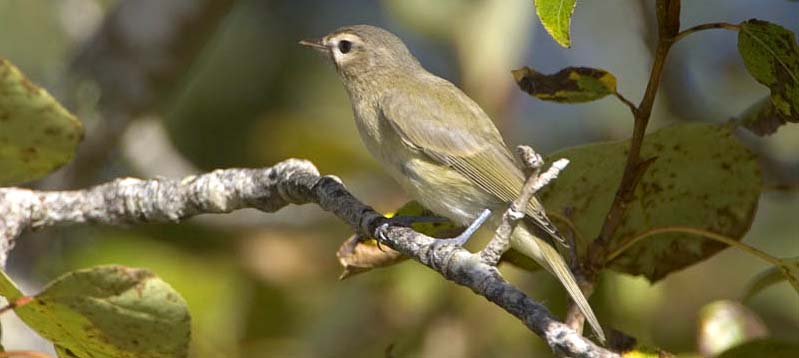

| During fall migration, California birders often head for coastal 'vagrant
traps' such as the riparian habitats at important river mouths. In Monterey
County, those spots include the Carmel River mouth and Big Sur River mouth.
At these spots it is likely that the observer will encounter migrant Warbling
Vireos. On occasion, good numbers may be encountered, especially in late
August and throughout September. Numbers decline thereafter and by November
any Warbling Vireo is rather scarce and late.
Warbling Vireo is a mid-sized, slim, small-billed vireo that is reasonably long-winged, long-tailed, and has a "blank" expression caused by a white supercilium and extensive white below the eye (above). It is otherwise usually rather plain, with dull olive upperparts, a dull grayish cap, and whitish underparts with (often) yellow on the flanks or undertail coverts. Each year, a very few Philadelphia Vireos are reported. Philadelphia Vireo is a rare eastern vagrant to California, breeding mostly in alder-spruce forests from Alberta to Maine, and migrating to winter in Central and South America. Some of these reports will be correct, but a significant percentage will be erroneous. The experience of the California Bird Records Committee (CBRC) has been that about one out of every four reports of 'Philadelphia Vireo' is unconvincing; almost all of these are misidentified Warbling Vireos. Therefore a review is warranted. One problem is that too many observers rely on their field guides to identify vagrants. Field guides are not designed for this purpose, and cannot show the range of variation that may create problems. Field guides — even excellent new ones like Sibley or National Geographic — show 'standard' individuals. There is excellent literature about the Warbling v. Philadelphia Vireo problem, and more observers should review this literature before claiming vagrants. Excellent discussions are in Terrill & Terrill (1981), Zimmer (1985), and Kaufman (1990), and some highlights are in Roberson (1980, 1986, 1993). The Kaufman book — Field Guide to Advanced Birding — should be in everyone's library as an immediate reference. The points discussed below are all covered in the literature. |
| The first key is to understand the plumages and molt of our common
bird: Warbling Vireo. Warbling Vireo nests in deciduous woodlands throughout
northern California, and local observers become accustomed to the dull,
grayish above, whitish below, worn plumage of adults, such as the upper
bird (right) photographed at the beginning of migration in early August.
When youngsters hatched that year begin their migration in fresh first-year
plumage (right, below), an observer can be unprepared for how bright and
colorful it is. These birds are much greener above, and have much more
yellow below. Indeed, some have exceedingly bright yellow undertail coverts
and flanks, and some have yellow washing across the entire underparts.
It all cases, however, the brightest yellow is on the undertail coverts
and the faintest on the throat.
Photos right: top © D. Roberson, 3 Aug 1981 Pajaro
R. mouth MTY; bottom © Bill Hill, 13 Sep 2004 Carmel R. mouth
|
|
| Observers often overlook the effect that light (particularly sunshine) that is filtered through green and yellow leaves can have on the appearance of birds in the field. A bird that is essentially white below can look yellowish in some views (see below, left). In addition, fresh plumage can increase the appearance of contrasting colors. Note how dark gray the cap of the Warbling Vireo (below right) may appear |
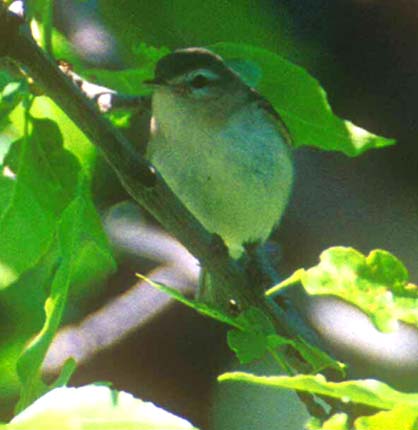 |
Both photos here are from Carmel R. mouth, a site that is very
prone to color misconception
© D. Roberson |
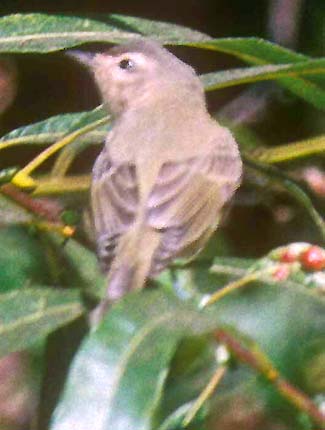 |
| The field guides emphasize that a dark line through the lores is a key character of Philadelphia Vireo. This is a useful and critical point but the observer needs to understand the range of variation in Warbling Vireo. It is not a simple "yes/no' characteristic. Below are close-ups of the heads of five Warbling Vireos. Many individuals look like the two left-hand-most birds: little or no eye-line in front of the eye, leaving the lores pale. But a fair number are like birds #3 and #4: a thin bit of eyeline extending forward from the eye into the lores. Rarely, Warbling can have a quite prominent line through the lores, as in the right-hand-most individual. This individual was photographed at Pt. Reyes on 5 Sep 1982, and was featured in a monthly quiz on Joe Morlan's web site. | |||||
|
|||||
|
The middle three were photographed in Monterey County; the sketch is also of a MTY bird.
|
|||||
| Joe Morlan discussed the difference in these comments from his web
site: "One feature worth noting is that the lore mark on a Philadelphia
Vireo is shaped more like a wedge than an even stripe. It is widest at
the eye, and narrows down to a point towards the bill. [The photographed]
Warbling Vireo [shown above, far right] has its lore stripe thickest at
the bill and slightly narrower at the eye, a reversal of the usual Philadelphia
Vireo pattern."
The "wedge-shaped" character of the loral line of Philadelphia Vireo is consistent in all of these birds. The line is very broad directly in front of the eye — it is often broader here than behind the eye. This seems to never happen in Warbling. Obviously, determining the shape of the loral mark takes some good, close views. This is one reason I am skeptical of claims of Philly Vireo seen only at the top of a tall cottonwood. On the middle Philadelphia shown above, the front part of the loral line is obscured somewhat, looking to be an "incomplete" line in the field. This can happen in Philly Vireos but the part of the line next to the eye is still very broad and prominent. There is something else to note in these facial patterns. On Warbling Vireo, the white supercilium usually expands above or behind the eye, and then continues on as a broad band for some distance before narrowing and fading toward the nape. There is variation in this pattern but the general shape just described is there on most birds. On Philadelphia Vireo, the broadest part of the white supercilium is often in front of the eye, and in many cases the supercilium stops rather abruptly behind the eye. This feature, combined with a shorter neck and more rounded head, gives Philly Vireo a 'cuter' expression than the 'blank-faced' look of Warbling Vireo. Also note the variation in the white areas below the eye. In the top row of Warbling Vireos, birds #2 and #3 are the same bird but note how different the facial expression looks in different angles and lights. Birds #1, #2, and #5 show a lot of white below the eye; bird #4 shows very little. On Philadelphia Vireo, the amount of white below the eye is also variable, being sometimes as intense as the supercilium (e.g., #1, #2, and #4) but sometimes decidedly less noticeable (#3). It is very likely that the sketch (#5) overlooked the white below the eye as the focus of the observer was in capturing the shape of the dark loral area; note also how the sketch grossly overstates the thickness (but not the length) of the bill. Photos above: top (L to R) Warbling: 22
Jun 1997 Big Sur R. mouth MTY © D. Roberson ; next two (same bird,
different angles) 13 Sep 2004 Carmel R. mouth MTY © Bill Hill ; 15
Nov 1994 Big Sur R. mouth © BSOL (J. Booker); 3 Sep 1982 Pt. Reyes
MRN © Albert Ghiorso.
|
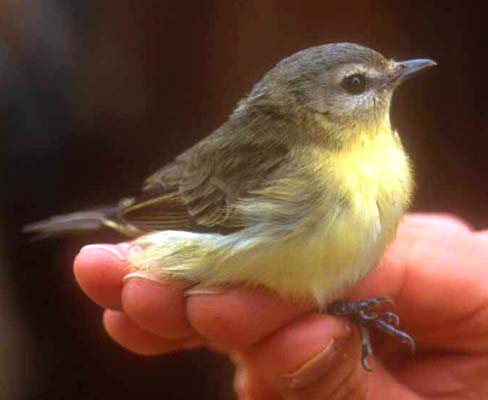 |
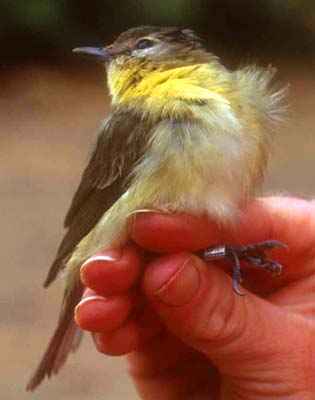 |
| There is also an important difference in the distribution of yellow
on the underparts of Philadelphia Vireos (all in-hand photos above
& right, all MTY captures). Philadelphia Vireo usually looks quite
yellow below, including the breast, belly, and undertail coverts (e.g.,
above or right) but when one must evaluate changes in intensity of the
yellow, or in some lighting conditions (see above right), the most intense
yellow is on the center of the breast and throat. All Philadelphia
Vireos have yellow on the throat. The intensity of the yellow color varies
from Philly to Philly, but the areas that have the most intense color do
not.
In contrast, the most intense yellow on the underparts of bright Warbling Vireos are the flanks and undertail coverts, and especially the latter. Most Warbling Vireos lack yellow on the throat but, when it is there, it is not as bright as the sides, flanks, or undertail coverts. The Warbling (below) has a wash of yellow to the sides of the throat and to sides of breast, but it is most intense on the sides and the center of the breast is less yellow. 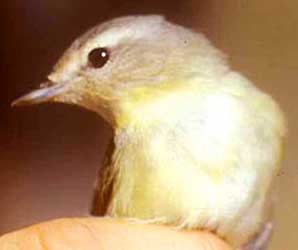 |
 |
| Photos above: top row Philadelphia (both shots) 6 Oct 2001 Big Sur R. mouth © D. Roberson; right-hand Philadelphia above 27 Oct 1998 Big Sur R. mouth © BSOL (J.N. Davis); Warbling Vireo, just above to left, and below, 15 Nov 1995 Big Sur R. mouth © BSOL (J. Booker). | |||||||||||||||||||||||||||||||||||||
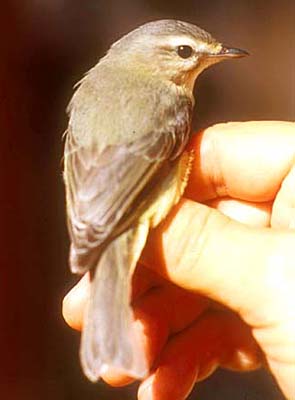 This
Warbling
Vireo (left) illustrates how colorful a Warbling can be on its
upperparts. The back can be quite greenish and the crown contrastingly
grayish. Philadelphia Vireo also has this contrast (green back,
gray cap), as shown in some shots above, but it is even more dramatic.
Many Warblings show little or no contrast. The point is that Warbling is
variable in this characteristic, so a "green back, gray cap" does not necessarily
indicate a Philadelphia. Any claimed Philly, however, should show this
contrast. This
Warbling
Vireo (left) illustrates how colorful a Warbling can be on its
upperparts. The back can be quite greenish and the crown contrastingly
grayish. Philadelphia Vireo also has this contrast (green back,
gray cap), as shown in some shots above, but it is even more dramatic.
Many Warblings show little or no contrast. The point is that Warbling is
variable in this characteristic, so a "green back, gray cap" does not necessarily
indicate a Philadelphia. Any claimed Philly, however, should show this
contrast.
Philadelphia also looks shorter-tailed and more round-headed in the
field than the typical Warbling, but this is so subjective as to be useful
only to the observer who already has lots of experience.
|
|||||||||||||||||||||||||||||||||||||
Finally, I want to emphasize the timing of vagrant records in
California. The timing of vagrant Philadelphia Vireos in California fits
within their pattern of migration back East. In Louisiana, for example,
Philadelphia Vireo is a common fall migrant from late September to November,
peaking in October (Remsen et al. 1996). Likewise, in California, Philadelphia
Vireo occurs primarily in late September and October. Claims of birds before
mid-September are particularly dubious. This chart illustrates that trend.
It segregates all California records (through 1996) and all MTY records
to date (even those after 1996) into 8 classes by dates. Note that these
are ten-day date spans (until the month of November):
In fall migration in California, some claims of Philadelphia Vireos are unpersuasive at any date, but in peak periods for this vagrant (late September through October) this error rate is only about 15%. Mistakes are much more common in early September (when Warbling Vireos are very common and at their brightest) and in November (when either species is quite late). There are no acceptable claims of Philadelphia Vireo in August at all. In fact. the four earliest dates of Philadelphia in California are:
|
Kaufman, K. 1990. A Field Guide to Advanced Birding. Houghton Mifflin, Boston, MA.Use these links to reach other portions of the Monterey County list:
Pyle, P. 1997. Identification Guide to North American Birds. Slate Creek Press, Bolinas, CA.
Remsen, J.V., Jr., S. W. Cardiff, and D.L. Dittmann. 1996. Timing of Migration and Status of Vireos in Louisiana. Journal of Field Ornithology 67:119-140.
Roberson, D. 1980. Rare Birds of the West Coast. Woodcock Publ., Pacific Grove CA.
Roberson, D. 1986. Ninth report of the California Bird Records Committee. West. Birds 17:49-77.
Roberson, D. 1993. Fourteenth report of the California Bird Records Committee. West. Birds 24:113-166.
Terrill, S.B., and Terrill, L.S. 1981. On the field identification of Yellow-green, Red-eyed, Philadelphia, and Warbling Vireos. Continental Birdlife 2:144-149.
Zimmer, K.J. 1985. The Western Birdwatcher. Prentice-Hall, Englewood Cliffs, NJ.
Part 1: Waterfowl through GrebesReaders may use this material for their own private enjoyment, study, or research but none of the photos or text herein may be used commercially nor may they be reposted on other web sites without written permission. All material is copyrighted. The posting of photos and text on this private web site is not a submission to review organizations.
Part 2: Albatrosses through Frigatebirds
Part 3: Herons through Cranes
Part 4: Plovers through Sandpipers
Part 5: Jaegers through Alcids
Part 6: Doves through Woodpeckers
Part 7: Flycatchers through Larks
Part 8: Swallows through Pipits
Part 9: Waxwings through Warblers
Part 10: Tanagers through Sparrows
Part 11: Grosbeaks through Finches
or just the plain Checklist (no annotations)